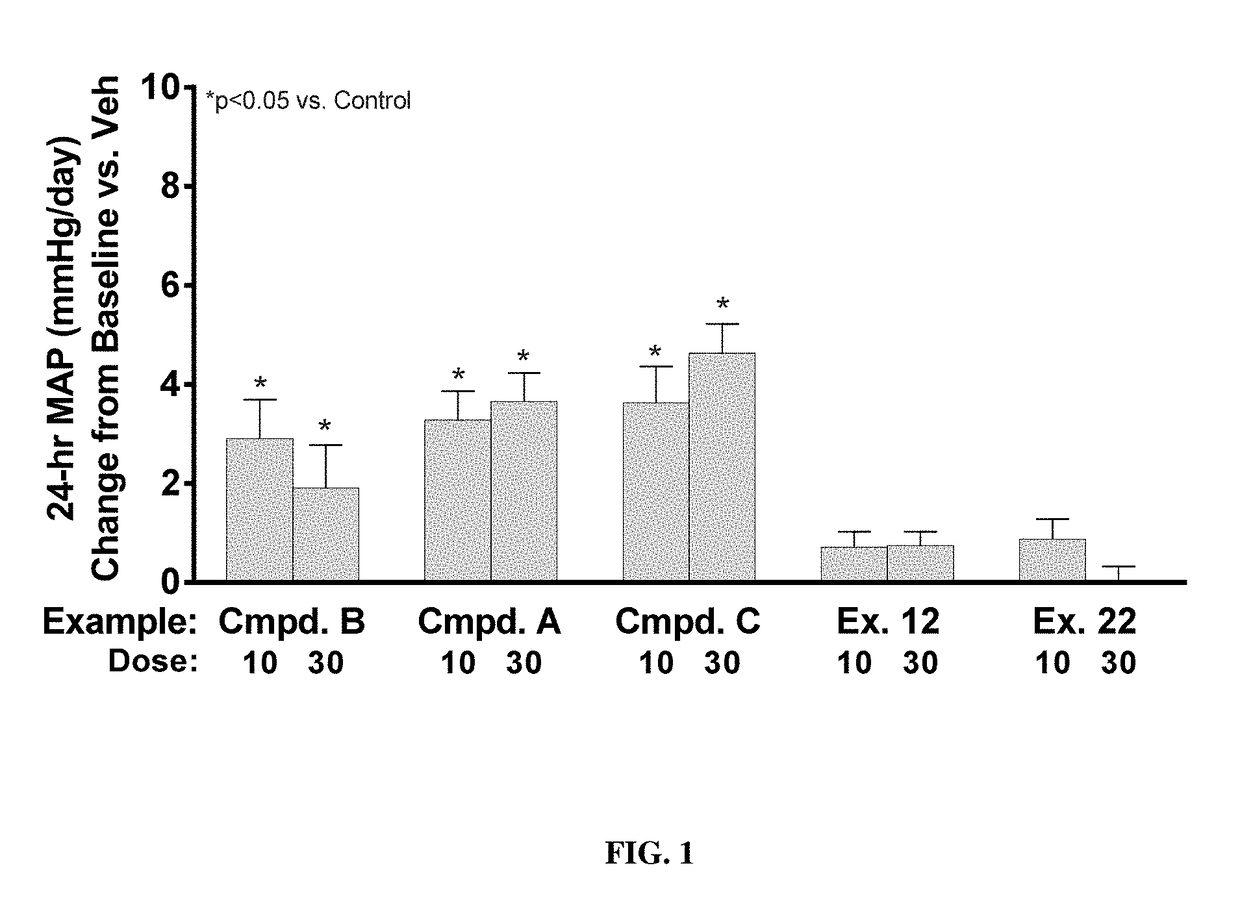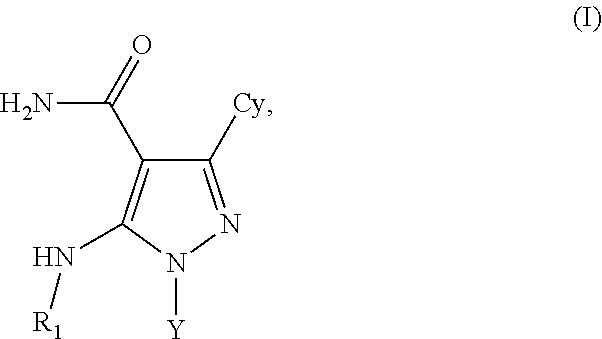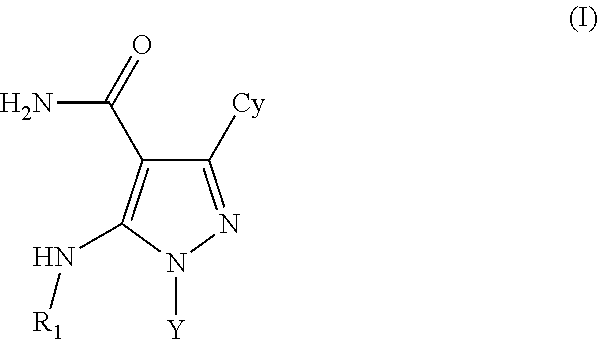Heteroaromatic compounds as btk inhibitors
- Summary
- Abstract
- Description
- Claims
- Application Information
AI Technical Summary
Benefits of technology
Problems solved by technology
Method used
Image
Examples
example 1
Synthesis of Example 1
[0228]
[0229]I-110 (84 mg, 0.17 mmol) is treated with a 4.0M HCl solution in dioxane (0.427 ml, 1.7 mmol) and stirred at rt for 0.5 h. The reaction is concentrated in vacuo to afford 120 mg of I-158. To a solution of acryloyl chloride (0.03 ml 0.37 mmol) in CH2Cl2 (5 mL) is added I-158 and DIEA (0.15 mL, 0.84 mmol). After stirring at rt overnight, saturated aqueous ammonium chloride (4 mL) is added and the mixture is extracted with EtOAc (4×20 mL). The combined organic extracts are dried over sodium sulfate, filtered and concentrated in vacuo. The residue is purified by RHPLC (Column: Luna PFP(2) Prep; Gradient: 25% to 30% ACN in Water (0.1% TFA)) to give 5 mg of Example 1.
[0230]The following compound is made in similar fashion: Example 26.
[0231]Method X
example 2
Synthesis of Example 2
[0232]
[0233]To a solution of I-139 (220 mg, 0.42 mmol) in CH2Cl2 (5 mL) is added a 4.0M HCl solution in dioxane (2.0 ml; 8.0 mmol) and the reaction is stirred at rt for 16 h. The solution is concentrated in vacuo to afford 175 mg of I-159.
[0234]To a solution of 2-butynoic acid (35 mg; 0.41 mmol) in THF (5 ml) is added isobutyl chloroformate (62 mg; 0.45 mmol) and N-methylmorpholine (166 mg; 1.6 mmol). The reaction is stirred at rt for 15 min then is transferred to a solution of I-159 (175 mg; 0.41 mmol) in THF (10 mL) and stirred for 1 h at rt. The mixture is then portioned between 10% MeOH in CH2Cl2 and water and filtered through a phase separator and filtrate is concentrated. The residue is purified by flash chromatography (SiO2, Ethyl acetate in heptane 0-100%, then MeOH in CH2Cl2 0-20%) to yield, after concentrating in-vacuo, 127 mg of Example 2.
[0235]The following compounds are made in similar fashion: Examples 3-9, 13, 14, 19, 24, 27-29, 34-37, 44, 52-60....
example 12
Synthesis of Example 12
[0237]
[0238]To a solution of I-130 (57 g, 102 mmol) in CH2Cl2 (250 mL) is added a 4.0M HCl solution in dioxane (101.9 mL, 407.4 mmol). This reaction solution is allowed to stir at rt for 16 h then concentrated in vacuo to afford 57.5 g of I-160 that is used without further purification. A solution of 2-butynoic acid (11.6 g, 138 mmol) in IPAc (228 mL) is cooled to 0° C. and isobutyl chloroformate (18 mL, 138 mmol) followed by N-methylmorpholine (50.5 mL, 460 mmol) are added sequentially dropwise. The solution is allowed to stir at 0° C. for 15 min then is transferred to a solution of I-160 (57 g, 115 mmol) in IPAc (200 mL). The reaction mixture is stirred for 1 h then diluted with 300 mL of water and warmed to 50° C. for 3 h, then stirred overnight at rt. The heterogeneous mixture is vacuum filtered and the solid is washed with water, collected and dried to yield 39 g of Example 12. The filtrate is collected and layers are separated. The IPAc layer is concentr...
PUM
| Property | Measurement | Unit |
|---|---|---|
| Volume | aaaaa | aaaaa |
| Molar density | aaaaa | aaaaa |
| Molar density | aaaaa | aaaaa |
Abstract
Description
Claims
Application Information
 Login to View More
Login to View More - R&D
- Intellectual Property
- Life Sciences
- Materials
- Tech Scout
- Unparalleled Data Quality
- Higher Quality Content
- 60% Fewer Hallucinations
Browse by: Latest US Patents, China's latest patents, Technical Efficacy Thesaurus, Application Domain, Technology Topic, Popular Technical Reports.
© 2025 PatSnap. All rights reserved.Legal|Privacy policy|Modern Slavery Act Transparency Statement|Sitemap|About US| Contact US: help@patsnap.com



